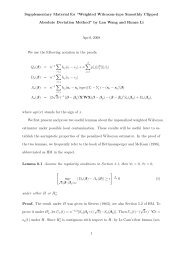Supplementary Web Material - Biometrics
Supplementary Web Material - Biometrics
Supplementary Web Material - Biometrics
Create successful ePaper yourself
Turn your PDF publications into a flip-book with our unique Google optimized e-Paper software.
nominal power when nzp = 50 for all specifications studied except when ρc < 0.5 (i.e., the<br />
specifications requiring the largest sample size). We also see that, like with internal pilot<br />
studies, the median required sample size per group decreases with increasing nzp. This<br />
result reflects that when nzp is larger compared to when it is smaller, inflation factors<br />
are closer to one owing to larger degrees of freedom in (2) and more precise estimates of<br />
variance and ρc from pilot data.<br />
Conclusion<br />
Although more accurate approximations for the distribution of a sum of weighted noncen-<br />
tral chi-square variables have been proposed (e.g., Castaño-Martínez and López-Blázquez,<br />
2005), their mathematical complexity limits their use and practicality for calculating sam-<br />
ple size. Further, the simulation studies show that using the Welch approximation for<br />
degrees of freedom in the inflation factor and resulting t-tests performs reasonably well<br />
for controlling type I error and attaining desired power in the presence of noncompliance.<br />
The main factor that impacts the performance of the methods is the ratio of nzp to the<br />
total required sample size. If ρc is expected to be small, then nzp should be chosen to<br />
have a sufficient number in each adherence subgroup to provide a reasonable estimate of<br />
subgroup means and variances for precisely estimating treatment-group variances, partic-<br />
ularly when large levels of selection bias are expected.<br />
Zucker et al. (1999) discussed concerns about jeopardizing blinding for internal pi-<br />
lot studies that are relevant here. In particular, unblinding may risk interim testing in<br />
addition to sample size calculation, which further impacts type I error. The authors<br />
noted that interim sample size calculation without testing can be allowed by disclosing<br />
treatment-group variance estimates, but not interim mean differences. To adapt this rec-<br />
ommendation to allow noncompliance, the interim compliance proportion estimate also<br />
8




